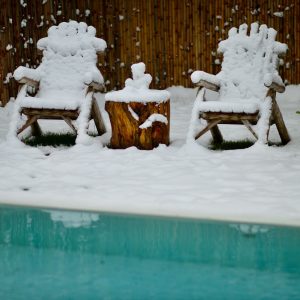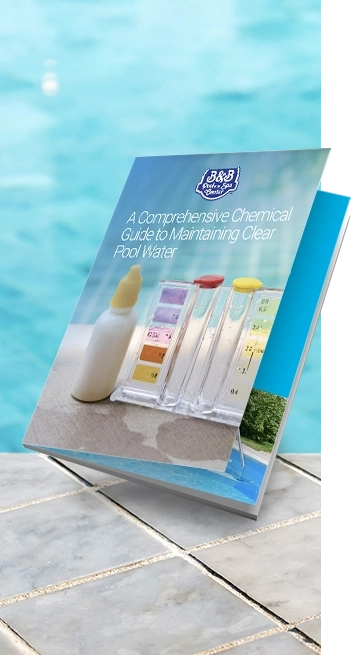Risks of Winter: Protecting your Pool in the Off-Season
Pool Education
As a pool owner, you may be familiar with some potential dangers winter can bring to your pool structure. To take proper precautions and preparations, you should understand how to maintain your swimming pool during the cold winter months. We’ll look at what types of risks are involved with the winter season to help you ensure the health and safety of your pool and pool structure.
Winter Prep is Essential
We have discussed in past articles how you can prep your pool for a major storm, and some of those points can be applied to your winter prep. Let’s overview!
- Winterization is essential to keeping your pool clean and sanitized for the winter months. It also aids in keeping your pool from freezing at the tile line, lowering the chances of damage.
- In preparation for the freezing temperatures, it’s essential to use winterizing chemical kits to properly balance your pool’s chemistry. The chemistry of your pool year-round is vital to its health and wellness. Your pool’s chemistry will change with additional water from snow and ice. Therefore, it’s important to add enough chemicals at winterization to last until spring. By preventing algae growth in the off-season, spring clean-up at the pool opening is also simplified.

What Are the Risks of Winter?
One of the greater concerns during the winter months is the potential for freezing temperatures. Naturally, this can wreak havoc on any swimming pool, making winterization more imperative. But what can happen if your pool freezes without being properly protected?
Freezing Damage behind Coping & Tile
Water expands when it freezes. When water intrudes into confined spaces, like below the coping or behind the tile line, freezing damage can occur. These trapped pockets of water can thaw and refreeze multiple times across the winter season, wedging apart masonry and other rigid materials.
Remember when we spoke about covering your pool and lowering the water when you close for the season? Keeping the water level below the tile line is the best way to prevent water from intruding into these vulnerable spaces.
Another way to protect your pool from winter damage is maintaining your expansion joint. This is a flexible and waterproof strip that runs between your pool coping and patio. The expansion joint is flexible to allow for your patio to shift without damaging the coping. It also functions as a waterproof barrier to prevent water from seeping below the coping and freezing.
Winter Cover Concerns
Your pool cover can help reduce the snow that builds up directly on the water’s surface. Winter covers also aid in keeping your pool at a warmer temperature, reducing the extent of freezing. However, they still require attention throughout the winter, or else they can cause their own types of damage.
Solid pool covers will prevent snow, ice, & debris from passing through to the pool below. This keeps the pool clean & prevents the water level from rising. However, excess weight can build up on the cover, putting strain on the anchors that are installed in the patio. We recommend using a cover pump on top of the cover, to remove excess water as snow and ice thaw.
Mesh pool covers are a great alternative, as they allow melted ice and snow to pass through the cover, preventing heavy build-up. This prevents too much weight from accumulating on the cover, while still providing coverage from debris and preventing accidental fall-ins. When this type of cover is used, we recommend installing a cover pump below the cover, to maintain water levels as they rise due to rain or melting snow.
Freezing Water Lines
A basic pool system consists of filtration, drainage, pump, returns, and plumbing. These parts work together to clean your pool and keep it operational. Therefore, it’s imperative that you take the proper steps to winterize your pipes and drainage to lessen the damage potential.
Draining your pipes and equipment will keep water from freezing and prevent cracks in your lines and even in your pump. A professional should repair the damage caused by freezing pipes to guarantee the job is done correctly.
Indications of a cracked pipe can be leaking, puddles of water in your yard, water under your equipment, drastic changes in water level, dirt entering from your returns into your pool, and a higher-than-normal water bill. To prevent this from happening to your swimming pool, you must blow out and close all necessary plugs so that water can’t enter.
Spaces Surrounding Your Pool Are at Risk
Damage caused by freezing temperatures and snow affects more than just your pool and its structure. The cold winter season can also cause issues with your pool equipment, slides, diving boards, surrounding decks, and, worst cases, the lower levels of your home. Therefore, winter preparation and freeze prevention are essential for the health and safety of your property as a whole.
Regularly Check Your Pool During the Off Season
The potential for damage caused by the colder months means you must take the proper steps before the first freeze of the season to lower the potential for catastrophic damage and costly repair.
Maintaining your pool during the winter can be done yourself or through a professional program such as our Winter Watch Service. Hiring an experienced eye to oversee your pool during the season is a great option. They have the skill and expertise to know what to look for and when to act. Therefore, allowing pool owners to catch problems before they get too far out of hand, further protecting their swimming pools from the potential risks of winter.


